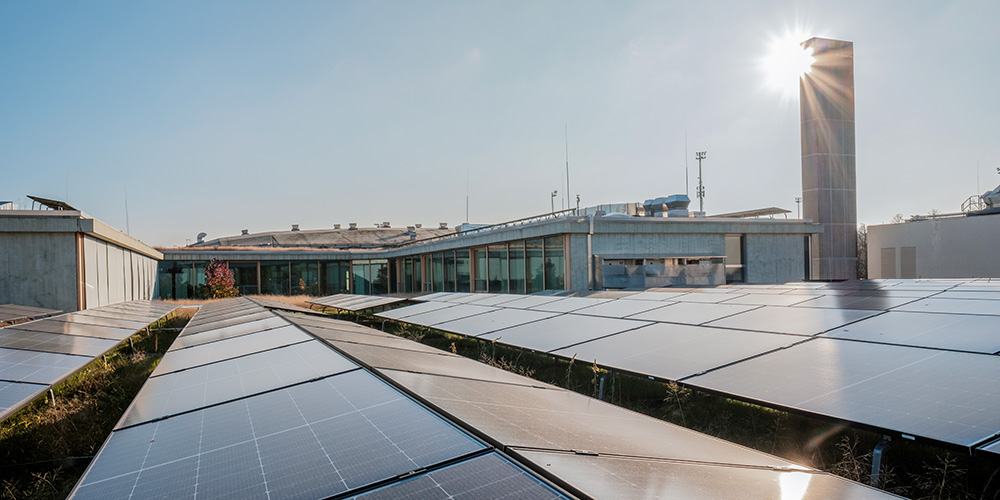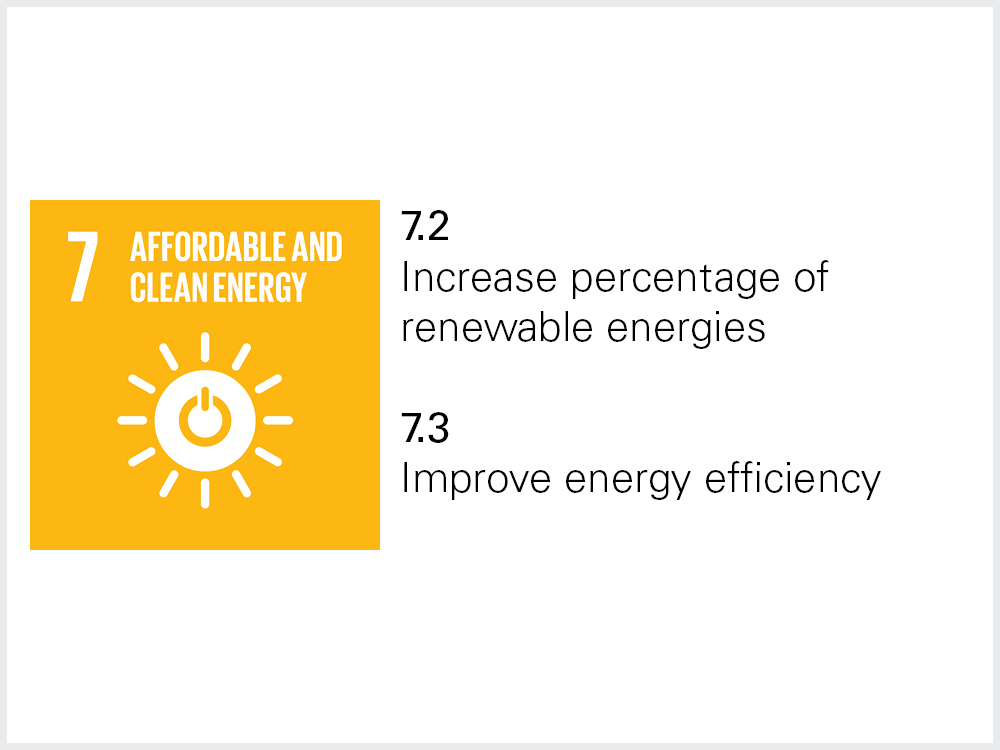Energy

In 2023, the University of Basel recorded a decline in electricity and heat consumption, however, these figures rose again in 2024. Consumption of district cooling decreased slightly in both years. The commissioning of the new photovoltaic system on the roof of the Department of Sport, Exercise and Health building was an important step forward in terms of renewable energy supply. This means that the University's own solar power production can be significantly increased in future. In addition to the ongoing identification and implementation of energy efficiency measures by the Infrastructure & Operations division, scientists contributed to conscious energy savings in day-to-day research through projects such as the ‘Electricity Saving Challenge’ and the ‘Green Lab Initiative’.
Power consumption
The energy requirements of the University of Basel are mainly covered with electricity (around 58% of total consumption in 2024), district heating (approx. 40%) and district cooling (approx. 2%). Total energy consumption rose from 59.3 GWh in 2023 to 63.8 GWh in 2024, which is due in particular to higher consumption at the Life Science Campus.1
Electricity consumption (including electricity for cooling by chillers) showed a continuous increase over the years, both in total and per capita terms.2 In relation to the usable floor area, however, consumption has remained largely constant. THere has been certain fluctuations in heat consumption in recent years, which can be caused by weather conditions, among other reasons3. In 2021, significantly more energy was consumed due to the parallel use of the old and new Biozentrum buildings during the relocation phase. The use of district cooling by the Petersplatz cooling network has remained at a constant level since the changeover in 2021.
Energy procurement and production: more solar energy
The photovoltaic system on the building of the Department of Sport, Exercise and Health (DSBG) in Münchenstein startet its operation in the autumn of 2024. With an area of approximately 1,400 m2, it is one of the largest PV systems in Basel and will be able to produce an average of around 302,000 kWh of electricity per year. Around 30% of the electricity will be used directly in the sports halls, seminar rooms and offices, while the rest will be fed into the electricity grid, which the DSBG also uses at night. The photovoltaic system on the pharmaceutical centre, which has been in place for some time, supplied a total of around 60,000 kWh of electricity in 2023 and 2024. In 2023 and 2024 the University of Basel continued to obtain the majority of its energy from renewable sources.
Measures to reduce energy consumption
Over the past two years, various measures have been implemented to optimise energy consumption and promote sustainable university operations: Building renovations, optimisations in building technology, lighting and cooling, use of energy management systems and raising user awareness. In order to monitor energy consumption in a targeted manner and identify further potential savings, various options for the development of the existing monitoring system have been tested and are to be implemented in the coming years. Initiatives such as the ‘Electricity Saving Challenge’ and the ‘Green Lab Initiative’ were launched to increase university members' awareness of energy consumption. These initiatives focus particularly on the user behaviour in laboratory settings. In addition to its own reduction targets in the climate strategy, the University of Basel, as a major consumer, is obliged to achieve an annual increase in energy efficiency of 2% over ten years in certain buildings. In 2024, specific measures were defined for seven energy-intensive buildings, which will be implemented and continuously evaluated over the coming years.4
Further measures and projects in the area of energy are presented in the following picture gallery:
Efficient use of computing resources
In recent years, the growing use of computer methods in research, such as artificial intelligence through ‘large language models’ in the social sciences and humanities, has resulted in an increasing demand for energy-intensive computing resources at the Centre for Scientific Computing (sciCORE). Efficient use of these resources is crucial, as inefficient methods, poorly organised workflows and unsuitable hardware allocation can significantly increase energy consumption. As a competence centre for scientific computing, sciCORE provides infrastructure, training and workflow optimisation in collaboration with the Center for Data Analytics (CeDA) to increase the efficiency of research.
To raise awareness, sciCORE analyses computing efficiency and integrates this data into monthly reports for research teams. The aim is to optimise the use of sciCORE by researchers in order to reduce costs and the ecological footprint. In addition, the centralisation of hardware management at sciCORE makes it possible to reduce inefficient systems. Through these measures, sciCORE helps to promote the sustainable use of computing resources.
[1] Higher energy consumption on the Life Science Campus is primarily due to consumption at the Biozentrum. It reached its full capacity utilisation for the first time during normal operation in 2024, including the occupation and expansion of all research quadrants, as well as the operation of the fish station.
[2] Reasons for the increase in electricity consumption are not fully understood. Possible explanations include increasing digitalisation, greater use of technical devices and energy-intensive research activities.
[3] Other factors such as changes in the use of space, relocations, increasing digitalisation and changes in user behaviour can also play a role.
[4] The measures were defined with the responsible landlords and the Canton of Basel-Stadt in accordance with the ownership situations.


